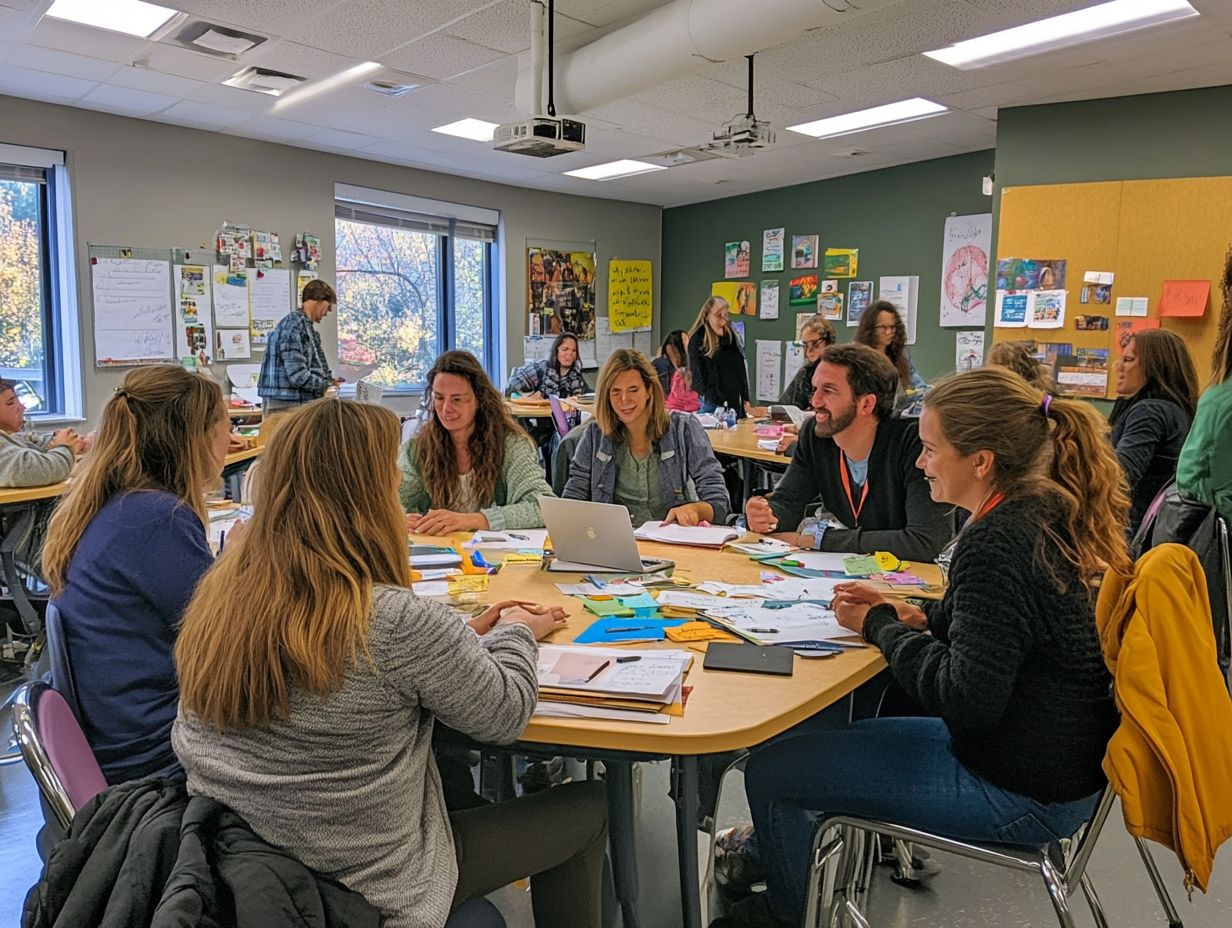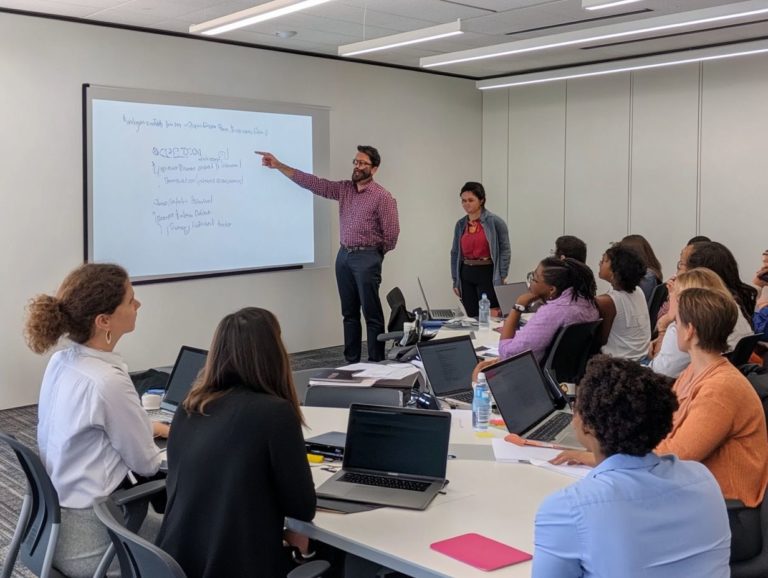How to Keep Training Engaging and Interactive?
In today s fast-paced world, engaging and interactive training is essential for you, whether you re a learner or a trainer. As the educational landscape evolves, creating an environment that captivates attention and fosters collaboration becomes crucial.
This article delves into the benefits of interactive training, highlighting how you can use multimedia tools and adapt to diverse learning styles. You ll also discover effective strategies for measuring engagement and ensuring continuous improvement.
Whether you’re a trainer aiming to enhance your sessions or a learner seeking to maximize your experience, this guide offers valuable insights tailored just for you.
Contents
- Key Takeaways:
- The Importance of Engaging and Interactive Training
- Creating an Engaging Training Environment
- Engaging Different Learning Styles
- Measuring Engagement and Effectiveness
- Tips for Maintaining Engagement
- Frequently Asked Questions
- 1. How can I incorporate technology to make my training more engaging and interactive?
- 2. What are some creative icebreaker activities that can make my training sessions more interactive?
- 3. How can I encourage active participation from my audience during training?
- 4. How can I make training sessions more interactive and less lecture-based?
- 5. How important is it to customize my training to different learning styles?
- 6. What are some ways to keep participants engaged and motivated throughout the entire training session?
Key Takeaways:

- Discover how engaging and interactive training can transform your learning experience!
- Engaging and interactive training benefits both learners and trainers, improving knowledge retention and overall effectiveness.
- Using interactive activities, multimedia, and adapting to different learning styles creates an engaging training environment.
- Continuous assessment, feedback, and incorporating new and relevant material helps maintain engagement and improve training effectiveness.
The Importance of Engaging and Interactive Training
Engaging and interactive training is essential for your employee development. It creates a more effective and enriching learning experience.
As the landscape shifts rapidly toward virtual training environments, it s imperative that you implement strategies that not only capture attention but also enhance workplace efficiency. This transition is particularly critical in instructor-led training sessions, where employee motivation can significantly impact the success of your training objectives.
By harnessing effective communication channels and employing interactive training techniques, you can ensure that your workforce remains dedicated and enabled to achieve their training goals.
Benefits for Learners and Trainers
Both learners and trainers can enjoy significant benefits from engaging and interactive training environments. These elevate the overall learning experience.
In these dynamic settings, you’ll find that retention rates improve as learners become more invested in their education. When you’re actively participating instead of just passively absorbing information, the material sticks better.
For example, a pharmaceutical company introduced a gamified training program a program that incorporates game elements into training and they saw a remarkable 40% increase in knowledge retention among their employees.
Trainers reap rewards too, with engagement leading to more productive sessions and valuable feedback. This ultimately boosts recognition for participants.
A case study from a tech firm showed how interactive workshops not only enabled employees but also enhanced the trainer’s credibility and success, resulting in a truly win-win scenario for everyone involved.
Creating an Engaging Training Environment
Creating an engaging training environment is vital for achieving optimal learning outcomes and nurturing a culture of continuous improvement within your organization.
Don t wait implement these strategies today to see immediate improvements in learning outcomes! You can accomplish this by employing a range of interactive training techniques that actively involve learners and by using effective communication tools like video conferencing and chat platforms.
When you make training commitments clear and set firm expectations, you cultivate an immersive training experience that captivates employees and enriches their learning journey.
Using Interactive Activities and Tools
Using interactive activities like breakout sessions, polls, and quizzes can significantly enhance your audience’s interaction and elevate the learning experience.
These elements create a dynamic environment that caters to various learning styles, encouraging participants to dive deeper into the material. For example, breakout sessions allow small groups to collaborate and discuss specific topics, fostering richer insights and a sense of community among learners.
Incorporating live polls enables you to gauge understanding in real-time, allowing you to make necessary adjustments to your training approach. Quizzes can introduce a fun, competitive edge that reinforces knowledge retention.
Consider organizations like ABC Corp, which have implemented these strategies in their training workshops. They saw a remarkable 30% increase in participant engagement and improved retention rates, demonstrating just how effective interactive activities can be in professional development.
Start transforming your training today by implementing these engaging strategies!
Incorporating Multimedia and Technology

Adding multimedia elements like videos, infographics, and digital storytelling can greatly boost learner engagement. These visual aids transform boring lectures into dynamic learning experiences that truly captivate your audience.
For instance, imagine a recruitment agency using short training videos that showcase effective interview techniques. This allows trainees to visualize best practices in action.
Infographics can also distill complex information into easily digestible formats, making it simpler for new employees to grasp company policies.
Job aids like checklists and quick-reference guides offer immediate help during real-world situations. This exciting blended approach caters to different learning styles and motivates employees to effectively use their skills.
Engaging Different Learning Styles
Engaging different learning styles is key to maximizing learner engagement. When you recognize that people have diverse preferences visual, auditory, or hands-on you can tailor your training to meet their unique needs.
By integrating a range of training formats and activities, your organization can create a more inclusive learning experience that resonates with a broader audience.
Understanding and Adapting to Different Learning Styles
Adapting to different learning styles can boost audience presence and participation. By using a mix of teaching methods, you can effectively engage visual, auditory, and hands-on learners.
For instance, introducing game-like elements such as point systems and leaderboards can ignite friendly competition among participants, transforming the learning process into an enjoyable and memorable experience.
Similarly, breaking content into microlearning segments delivers information in digestible bites, which is particularly beneficial for those who may struggle with traditional, lengthy training formats.
A notable case study illustrates this perfectly: a major corporation revamped its employee training program by integrating game-like elements and microlearning. The outcome? An incredible jump in retention rates and overall employee satisfaction, underscoring the importance of recognizing and embracing diverse learning preferences in the workplace.
Measuring Engagement and Effectiveness
Measuring engagement is crucial for ensuring your training programs hit their goals. Use effective assessment techniques and gather participant feedback for valuable insights into your training performance.
This practice helps identify both strengths and opportunities for enhancement. Systematically measuring engagement levels and training performance enables you to refine your training approaches, allowing you to make informed, data-driven decisions that optimize future training initiatives.
Assessment and Feedback for Continuous Improvement
Good assessment and feedback mechanisms are essential for overcoming training challenges. Evaluating learner performance can help you pinpoint where participants struggle and identify strengths for future sessions.
This ongoing evaluation not only highlights gaps in knowledge or skills but also reveals opportunities for enhancement.
By utilizing feedback whether from formative assessments or participant surveys you can refine your training resources and methodologies, creating a more effective learning environment.
Ultimately, this iterative process of assessment and enhancement not only elevates individual learning experiences but also significantly enhances the overall efficacy of your training programs.
Tips for Maintaining Engagement

Maintaining engagement throughout training is a continuous effort that demands innovative strategies. Keep the training fresh and relevant while actively encouraging participation and collaboration among learners.
Consistently evolve your training modules and incorporate new content to prevent stagnation and cultivate a dynamic learning environment. Engaging employees in training enriches their experience and fortifies their commitment to the organization s goals.
Keeping Training Fresh and Relevant
Keeping your training fresh and relevant is essential for meeting evolving goals and ensuring effective employee development.
Regularly assess and update your training content to reflect the latest industry trends and workplace demands. Use participant feedback to identify areas needing improvement and create more tailored materials that resonate.
Incorporate interactive e-learning modules or gamified training sessions to enhance engagement levels and improve knowledge retention. Leverage tools that show you how employees are performing right now to focus on specific competencies that need enhancement, making your training more relevant and impactful overall.
Encouraging Participation and Collaboration
Encouraging participation and collaboration during training enhances the overall learning experience and fosters a sense of community among employees.
Facilitators should create an environment where participants feel comfortable sharing their thoughts and experiences. This approach makes training more dynamic and impactful.
Use various communication channels, like video conferencing tools, chat platforms, and collaborative software, to engage actively, no matter where participants are located.
Workshops with breakout sessions facilitate small group discussions, enabling deeper conversations. Companies report remarkable improvements in team performance after implementing peer-to-peer learning groups, where employees share insights and tackle challenges together.
This approach leads to a more cohesive work environment and improves knowledge retention, making the experience more rewarding for everyone involved.
Frequently Asked Questions
1. How can I incorporate technology to make my training more engaging and interactive?
Integrate technology into your training to keep it engaging and interactive. Use interactive presentation software like Prezi or Powtoon for visually appealing slides. Online polling tools, such as Poll Everywhere or Mentimeter, can gather real-time feedback and opinions. Consider virtual reality or simulation technology for hands-on learning experiences.
2. What are some creative icebreaker activities that can make my training sessions more interactive?

Icebreaker activities are great for getting participants engaged. Ideas include:
- A group scavenger hunt where participants find items or information around the room.
- A speed networking activity where individuals chat for a limited time before rotating partners.
- A “two truths and a lie” game where each person shares facts about themselves, and others guess which one is false.
3. How can I encourage active participation from my audience during training?
Create a safe and inclusive learning environment to ensure active participation. Encourage everyone to share thoughts and opinions, actively listening to involve all participants in discussions. Incorporate group activities that require everyone s participation and provide opportunities for individual reflection and sharing.
4. How can I make training sessions more interactive and less lecture-based?
Lectures can quickly bore participants. To make your training sessions interactive, break up lectures with activities and group discussions.
Use visual aids like videos or infographics to convey information engagingly. Real-life examples also make the content relatable.
5. How important is it to customize my training to different learning styles?
Considering different learning styles is essential in planning effective training. People process information in various ways, so using diverse teaching methods will engage all participants.
Incorporate visual aids, interactive activities, and hands-on exercises. Observing your participants helps you adapt and maintain their interest.
6. What are some ways to keep participants engaged and motivated throughout the entire training session?
Avoid long lectures and include frequent breaks to maintain engagement. Vary the pace and activities to prevent boredom.
Incorporate energizers like quick physical activities or brain teasers to keep energy levels high. Providing incentives for participation boosts motivation.






